Jesse Ziegler | December 14, 2018
Hot Off The Line
Can the 2019 Suzuki RM-Z250 return Suzuki to production-class greatness? To help answer that question, we got our first chance to try out the all-new RM-Z.
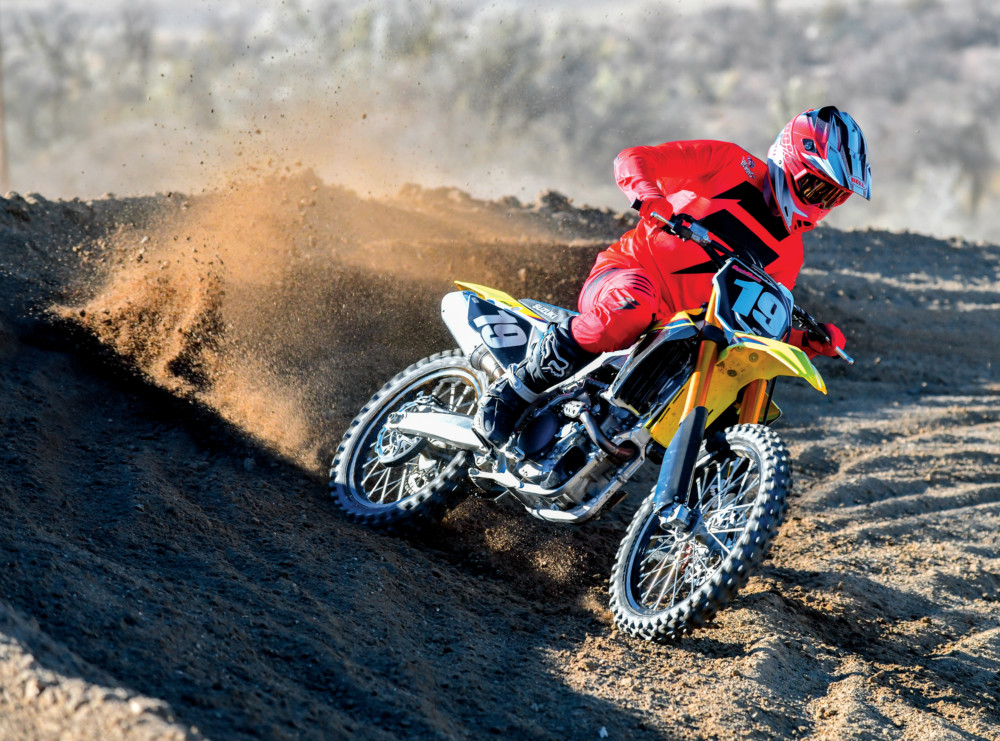 We’ve only had the 2019 Suzuki RM-Z250 in our hands for less than a week, but our six test riders who have already ridden the bike all agree that it’s improved significantly over the previous model.
We’ve only had the 2019 Suzuki RM-Z250 in our hands for less than a week, but our six test riders who have already ridden the bike all agree that it’s improved significantly over the previous model.
The 2019 Suzuki RM-Z250 is finally here. And it is one of the newest bikes we’ve ever tested on our local tracks here in California. As we write this, our test bike has only been in America for a few days and we threw it into our testing pool right away. It’s so new that we’ve barely broken it in with some good motos over a couple days. Luckily, one of those days was the first day of our 2019 250 shootout, so we had many riders jumping on and trying the bike out. Right now, we feel like we have a good baseline opinion of the bike, which include having tweaked on its suspension settings as far as our flat blades will allow. So, here’s our first impression of the new RM-Z250.
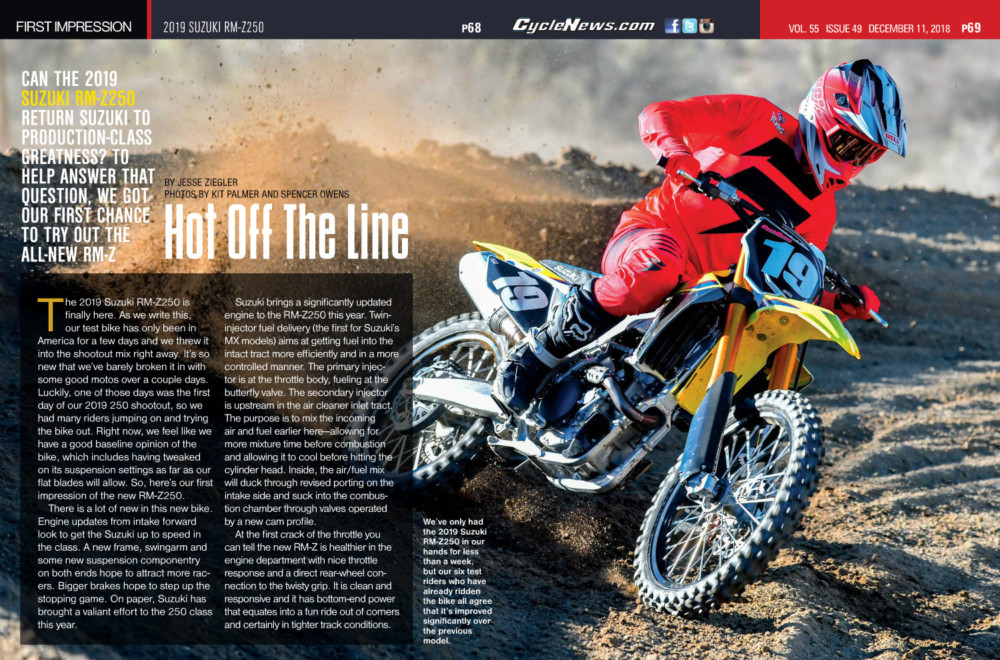
Photos by Kit Palmer and Spencer Owens
There is a lot of new in this new bike. Engine updates from intake forward look to get the Suzuki up to speed in the class. A new frame, swingarm and some new suspension componentry on both ends hope to attract more racers. Bigger brakes hope to step-up the stopping game. On paper, Suzuki has brought a valiant effort to the 250 class this year.
Suzuki brings a significantly updated engine to the RM-Z250 this year. Twin-injector fuel delivery (the first for Suzuki’s MX models) aims at getting fuel into the intact tract more efficiently and in a more controlled manner. The primary injector is at the throttle body, fueling at the butterfly valve. The secondary injector is upstream in the air cleaner inlet tract. The purpose is to mix the incoming air and fuel earlier here—allowing for more mixture time before combustion and allowing it to cool before hitting the cylinder head. Inside, the air/fuel mix will duck through revised porting on the intake side and suck into the combustion chamber through valves operated by a new cam profile.
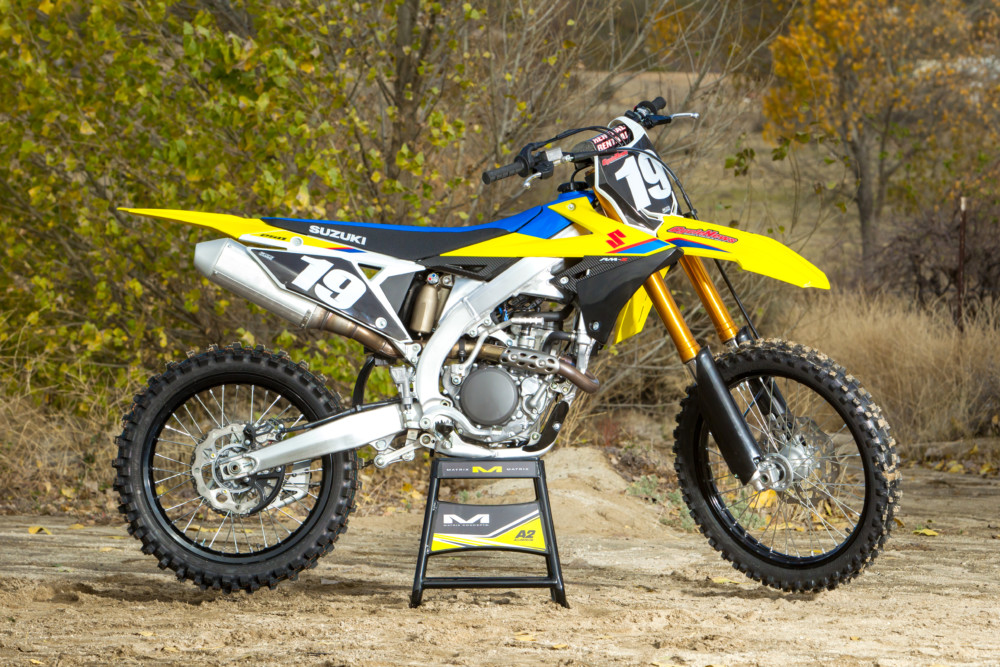 On the CN scale, the new RM-Z250 weighs 238 pounds, ready to race (fully fueled), which is the same as the 2019 Kawasaki KX250 and Yamaha YZ250F.
On the CN scale, the new RM-Z250 weighs 238 pounds, ready to race (fully fueled), which is the same as the 2019 Kawasaki KX250 and Yamaha YZ250F.
At the first crack of the throttle, you can tell the new RM-Z is healthier in the engine department, with nice throttle response and a direct rear-wheel connection to the twisty grip. It is clean and responsive, and it has bottom-end power that equates into a fun ride out of corners and certainly in tighter track conditions.
The new cylinder-head intake porting and intake camshaft seem to be tuned well for providing crisp throttle response and a grunty, meaty power pull from the bottom end into the mid. The bike barks and generates great traction at the same time. In our first rides, this fun and addictive initial power punch seems to wither a bit as rpm climb and speeds increase. Midrange is still healthy, but the bike would rather have a shift than simply sing into the uppermost revs.
This is a bit surprising from our first seat-of-the-riding-pants perspective seeing that Suzuki redesigned much of the intact tract and air box to flow more air and faster. The air-cleaner opening alone is a claimed 30-percent larger, after all. Even so, final-drive gearing changes may be necessary for riders looking for more top-end pull. With the strong bottom-end power character we’re experiencing from the motor, the RM-Z250 can possibly handle dropping a tooth on the rear for faster tracks or for riders who like to keep bikes pulling strong closer to the limiter. Final-drive gearing is likely one of the first tweaks we’ll try to the RM-Z as we move straight into shootout testing.
The new RM-Z250 is still kickstart only. Only two bikes in this class don’t have electric-start (Kawasaki’s unchanged 2019 KX250F is the other). They both seem dated compared to the modern electric-starting systems of the competition. Necessary in this class? Not really. But electric start is the new normal.
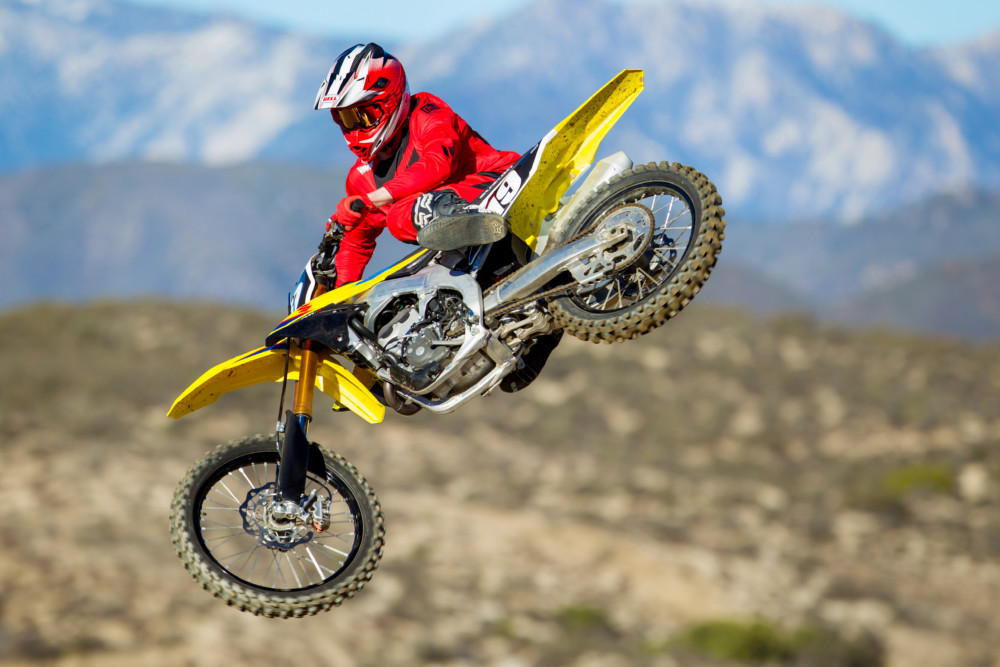 Get ready to throw the RM-Z250 all around. It loves it.
Get ready to throw the RM-Z250 all around. It loves it.
Suzuki is bringing other electronic tricks to the game. Their Suzuki Holeshot Assist Control (S-HAC) provides three modes of power management. There is a mode for slippery conditions or newer riders doing starts (A-Mode) and one for more aggressive power delivery where more traction is available and more skill is on-tap to control power delivery (B-Mode). There is also the standard Base Mode that offers standard power launch for those in-between situations. Each mode returns to original ignition settings after six seconds or shifting into fourth gear (whichever happens first).
Also onboard is Suzuki’s fuel-coupler EFI tuning. Suzuki gives owners two optional couplers to plug in—one providing richer-than-stock fueling and one providing leaner-than-stock fuel settings.
Finally, inside the Electronic Control Module (ECM), Suzuki programs a traction-management system. Suzuki claims this system constantly adjusts power delivery to maximize traction at all times by adjusting ignition timing and fuel-injector duration. This fine-tuning is not adjustable or manipulated by the rider. It’s embedded into the system. We can’t wait to compare traction to other bikes in controlled scenarios to see what it’s all about. Right away, we’re impressed with the bike’s ability to find traction with its low-end power bias. We’re not spinning out of control on corner exit.
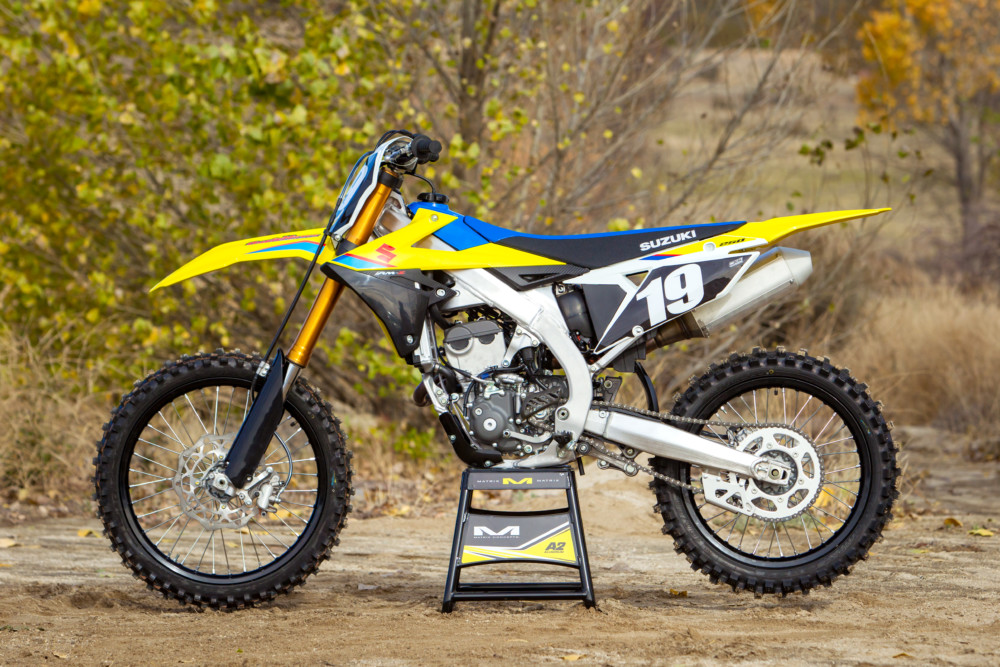 Basically, the 2019 RM-Z250 got a ground-up restoration, which includes trashing the previous air forks for new coil-spring forks.
Basically, the 2019 RM-Z250 got a ground-up restoration, which includes trashing the previous air forks for new coil-spring forks.
Suzuki also updated the RM-Z250 significantly for 2019 with chassis and suspension changes. The new frame and swingarm seem to be very rigid out-of-the-box, with an edge of precise control built in that seems to sacrifice compliance and flex in some other areas. Likewise, the new KYB shock and KYB coil spring front fork have a tight, harsh edge to them so far. We’re still breaking the bike in and looking for more compliance, but our initial impression is this bike is significantly stiffer than the competition. Most of our test riders have backed compression on the fork out significantly to get some compliance and comfort. While the shock adjustments have been across the board looking to calm some jarring sensations down on landings as well as acceleration chop.
On our second day aboard the bike, we actually tested a version of the RM-Z250 with lighter spring rates front and rear. Our lighter (and arguably fastest) test rider of the day said the lighter spring bike was a necessity for him and the stock spring rates were simply too rigid. Even our heavier vet-class guys backed the fork compression off more than five clicks in search of compliance. One of us experimented going stiffer, hoping to find more hold-up in the fork and possibly lighter compression-stroke valving. That didn’t work better than stock, so we’re still hunting here.
In the next weeks, we’ll be trying our best to wear these new suspension components down a bit and hope they free up. If not, we’ll be looking for more solutions via spring rates or valving adjustments.
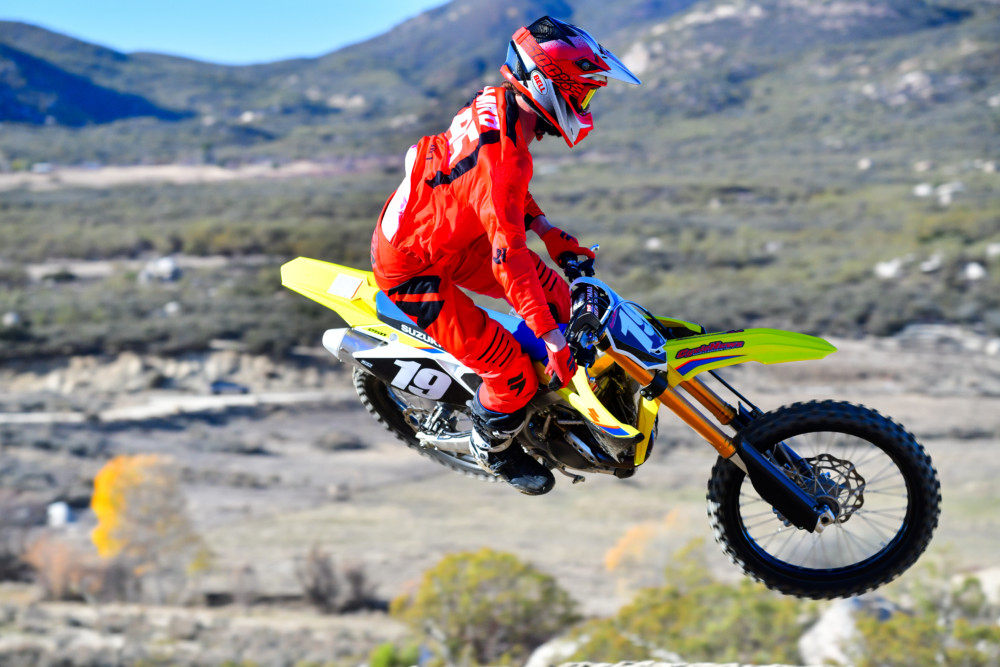 We’re still in the early stages of testing, but the RM-Z’s chassis feels a little on the rigid side, and the forks are not exactly plush.
We’re still in the early stages of testing, but the RM-Z’s chassis feels a little on the rigid side, and the forks are not exactly plush.
Regardless of our tuning-game status at the moment, we’re happy to see the return of a spring fork on the Suzuki, the previous air system wasn’t compliant or easily tunable and contributed to a less-than-stellar score on the compliance/ownership scale for Suzuki’s small-bore MX machine. We’re more confident we can make this suspension setup work after some break-in time and tuning.
Really though, the final culprit in the rigid feeling of the RM-Z might not totally be a suspension issue. The chassis itself seems ready for some tuning to find some flex. Suzuki claims the frame is lighter by almost a pound and has a 10-percent increase in torsional rigidity. Manipulating frame rigidity will likely be a key focus for tuners of RM-Z’s this year.
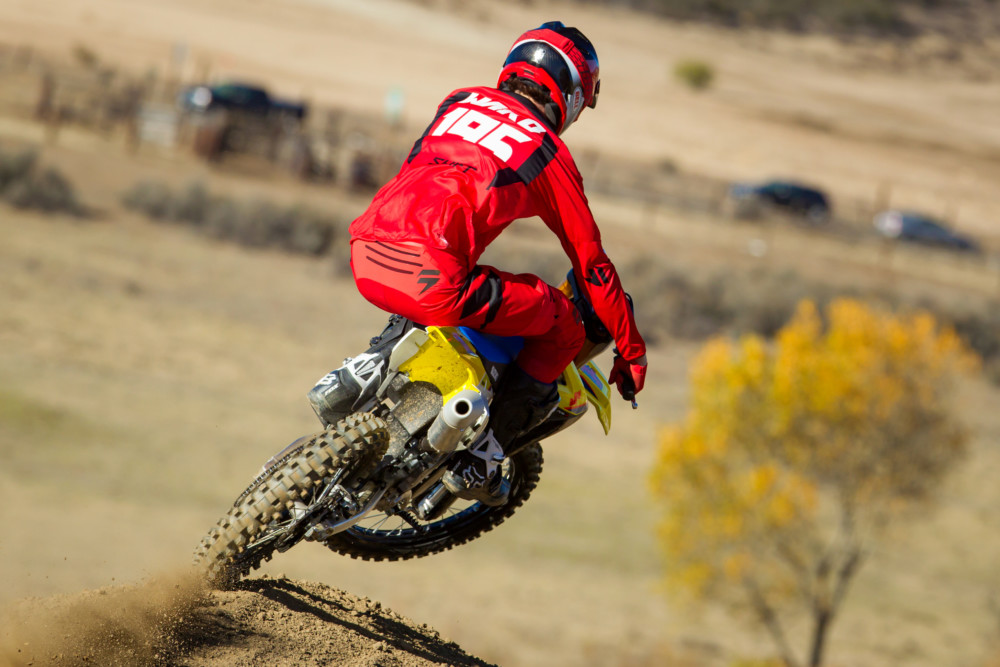 A much stronger engine puts the RM-Z back in the ballpark compared to its competitors.
A much stronger engine puts the RM-Z back in the ballpark compared to its competitors.
Even though our initial impressions of the RM-Z250 are that it feels very stiff and the power seems to sign off earlier than other models for most riders, some of our test riders recognized significant strengths of the power and chassis package. If you’re a local Arenacross racer looking for an ultra-precise package and appreciate a stiff chassis and baseline suspension setting, this is going to be a great starting point. The power delivery is good for accelerating up jump faces right out of corners and the suspension/chassis will be anything but wallow-y or vague as you hit course obstacles with aggression. This same test rider is heavy for a 250F—over 200 pounds—and has pro-level speed.
So, after a few days of testing, we can safely say Suzuki is bringing a more competitive racer’s bike to the market in 2019 than it has for a few years. Questions remain about top-end power improvements and handling compliance. But we’re looking forward to finding the answers. Stay tuned for more on this new ride from Suzuki. CN
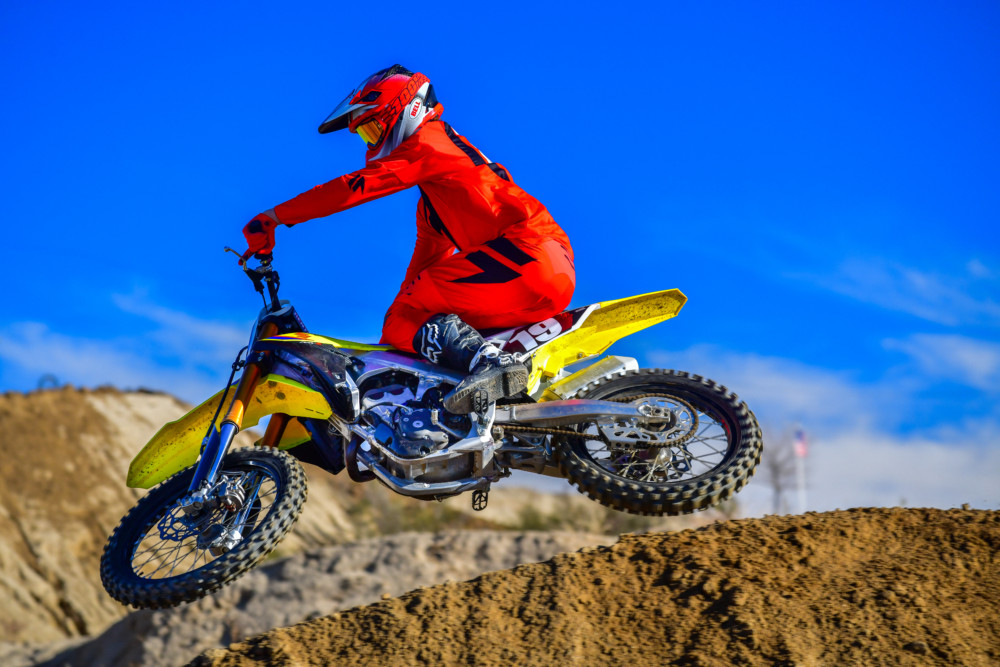 Check back later and see how the new RM-Z250 stacks up against its fellow rivals in our upcoming 2019 250F MX shootout.
Check back later and see how the new RM-Z250 stacks up against its fellow rivals in our upcoming 2019 250F MX shootout.
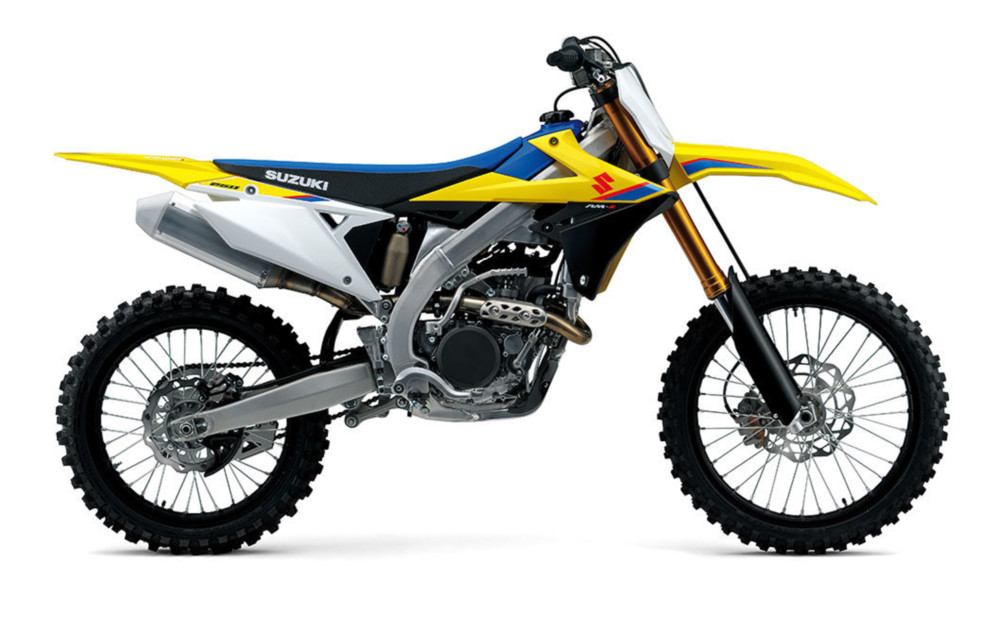
| SPECIFICATIONS |
2019 Suzuki RM-Z250 ($7899) |
| ENGINE: |
Liquid-cooled, 4-stroke, 4-valve, DOHC, single |
| DISPLACEMENT: |
249cc |
| BORE X STROKE: |
77.0mm x 53.6mm |
| COMPRESSION RATIO: |
13.75:1 |
| FUEL SYSTEM: |
Fuel injection, dual-injectors |
| STARTING SYSTEM: |
Kick w/automatic decompressor |
| LUBRICATION: |
Semi-dry sump |
| CLUTCH: |
Wet, multi-plate |
| TRANSMISSION: |
5-speed |
| FINAL DRIVE: |
Chain D.I.D 520DMA4K 114L |
| HOLESHOT ASSIST: |
Yes, 3-way S-HAC (Suzuki Holeshot Assist Control |
| EFI TUNING: |
Yes, via 3 couplers |
| TRACTION MANAGEMENT SYSTEM: |
Yes, ECM (Electronic Control Module) |
| FRAME: |
Aluminum |
| HANDLEBARS: |
Renthal, tapered aluminum |
| FRONT SUSPENSION: |
KYB, coil-spring fork, fully adjustable |
| REAR SUSPENSION: |
KYB, single shock, fully adjustable |
| FRONT BRAKE: |
270mm, single disc, 2-piston, wave-type, Nissin |
| REAR BRAKE: |
240mm, single disc, 1-piston, wave-type, Nissin |
| FRONT TIRE: |
80/100-21 in., Dunlop Geomax MX33 |
| REAR TIRE: |
100/90-19 in., Dunlop Geomax MX33 |
| RIMS: |
D.I.D DirtStar |
| SEAT HEIGHT: |
37.6 in. |
| WHEELBASE: |
58.5 in. |
| ACTUAL WEIGHT (full fuel): |
238 lbs. |
| FUEL CAPACITY: |
1.6 gal. |
| AVAILABILITY: |
February 2019 |